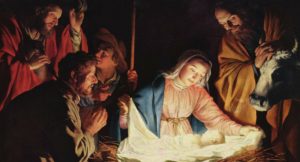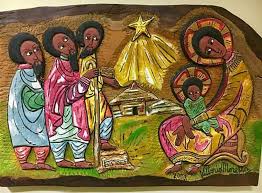The Unifying Hope of the Nativity - B. Bradley and S. Tesar
Before the Thanksgiving meal is cleared from the table, Christmas decorations are hauled out from attics and basements everywhere, including the ever-present nativity scene. Have you noticed the incredible diversity in the depictions of this all-important narrative? There is the classical European variety, such as this piece by Dutch artist Gerard Van Honthorst, which features a glowing baby Jesus:
 There are more colorful, iconic scenes, such as this painting from Uganda: There are more colorful, iconic scenes, such as this painting from Uganda:
 This beautiful work depicts the nativity of Jesus as it might have been, if he had been born in Japan under a blossoming cherry tree: This beautiful work depicts the nativity of Jesus as it might have been, if he had been born in Japan under a blossoming cherry tree:
 And believe it or not, there is even a 21st century “hipster” version, complete with selfies, Amazon delivery, segways, and iPads: And believe it or not, there is even a 21st century “hipster” version, complete with selfies, Amazon delivery, segways, and iPads:
 Artists have adapted this iconic scene to look like us, whatever our culture, ethnicity, or century. There is some merit to this approach, since Jesus is Lord and Savior of all nations and all cultures. On the other hand, these homogeneous depictions risk negating the diversity present in the original narrative. Artists have adapted this iconic scene to look like us, whatever our culture, ethnicity, or century. There is some merit to this approach, since Jesus is Lord and Savior of all nations and all cultures. On the other hand, these homogeneous depictions risk negating the diversity present in the original narrative.
2020 has been a year of great division. From fears about Covid-19 to feuds over the election, civil unrest, and social justice issues, this year has been a constant barrage of arguments and intense clashes over perceived differences. In a year that is so incredibly divisive, what hope for unity is seen in the diversity of the nativity story?
Let’s look at all the characters, beginning with Mary. This young peasant girl was looked upon with disdain by anyone who thought they knew her circumstances. From all appearances, she was an unwed pregnant girl who deserved to be stoned for her sinful ways. She said an angel told her the Holy Spirit made her pregnant and her child would be the Son of God. Who could believe this since no child has ever been conceived this way? Mary had the privilege of carrying the mystery of God in flesh within her own body for nine months, yet she was likely judged and misunderstood by others.
Joseph was rich in goodness and honor. He trusted the angel who told him to believe the unbelievable and take Mary as his wife. He was a simple, poor craftsman with the unfathomable job of serving as an adoptive father to God. While God chose Joseph to raise Jesus, Joseph must have been completely overwhelmed by the task. Even so, he demonstrated honor and love in the face of those who would accuse him of unrighteous living, and he persisted in following God even though it went against his culture.
A group of local shepherds were among the first to see the newborn king. Shepherds were not highly valued in that culture. They served a function in the economy by fulfilling a dirty job. This might be like inviting a group of sewage workers or auto mechanics to the birth today. This age-old profession goes back to Abel, and includes such people as Moses, David, and Rachel (Gen 29:9). Rachel? If women also served as shepherds, does this mean those who heard the angel’s announcement while watching their flocks in Luke 2 may have included some women? Perhaps Mary, the mother of Jesus, was not the only woman in the original narrative scene!
Delivering the message of hope to the shepherds was an enormous assembly of angels. These heavenly beings, so vastly different from their humble audience, were intrigued by the unique revelation of God they shared. Regarding God’s plan to save humankind, Peter writes that even the angels “long to look into these things” (1 Pet 1:12). These unearthly beings were privileged to make the announcement, yet they were still outsiders yearning to understand what God was up to at that unique juncture in history.
The magi may not have been present on the night Jesus was born, but they were aware of the circumstances due to their study of the prophecies and the stars. These wealthy foreigners traveled a great distance just to visit a couple of outcast peasants and to witness this miraculous event. The magi were considered kingmakers, and their journey was motivated by the hope of a new king’s reign.
All of these characters in the original nativity narrative represent different ethnicities, genders, socio-economic status, educational levels, and species. For the first time since Eden, hope had a defined human presence on earth. Jesus was born in the most humble of locations, welcomed by an incredibly diverse group. Paul writes that in his death, Jesus “himself is our peace, who has made the two groups one and has destroyed the barrier (Eph 2:14 NIV). While this ultimately occurs at the cross, it also occurred in some sense at the manger, where those who gathered bowed before him, regardless of their background or what language they spoke.
Jesus offers hope to a much broader audience than those in our own faith tradition or those who look like us. He offers hope to angels and sinners, rich and poor, educated and ignorant, male and female, old and young, and to black, white, and every other ethnicity on earth. He invites white collar and blue collar, Democrat and Republican, those who support Trump and those who do not, tee-totalers and junkies, regular church attenders and those who sleep in on Sundays, those who have been married for fifty years and those who have been married five times, those who worship with instruments and those who do not, those who attend Sunday School and those who do not.
The nativity offers the hope of a brighter, united future. The diverse characters point us to Jesus, who still wants to tear down barriers and bring us peace. Before 2020 draws to a close, consider where you are in this picture. How do you relate to the others who are looking to King Jesus? Is anything dividing you? Are we willing to worship alongside those who are different than us like those present at Jesus’ birth, or do we prefer a more homogenous group, like the culturally specific nativity scenes shown above? Let us work together to catch the beauty of the unique perspectives and differences of those God has invited to witness his greatest work - uniting the diverse people of all backgrounds and ethnicities through Jesus.
By Brandon Bradley and Sheri Tesar, December 26, 2020
Brandon Bradley serves as the Dean of Professional Studies at Central Christian College of the Bible. Brandon has an M.Div. and an M.A. Ministry Leadership from Hope International University, and a B.S. in Preaching Ministry from Central Christian College of the Bible. He is currently doing his doctoral studies on spiritual formation at Nazarene Theological Seminary.
Sheri Tesar is the director of the worship ministry degree program at Central Christian College of the Bible. She holds an M.A. in worship studies from Lincoln Christian University and a B.S. in worship arts from Dallas Christian College. She is currently in the final phase of pursuing her doctorate in worship studies from the Robert E. Webber Institute for Worship Studies.
Read more CGU articles from may others who love and support greater unity with in the Stone Campbell heritage at www.commongroundsunity.org/media/articles |